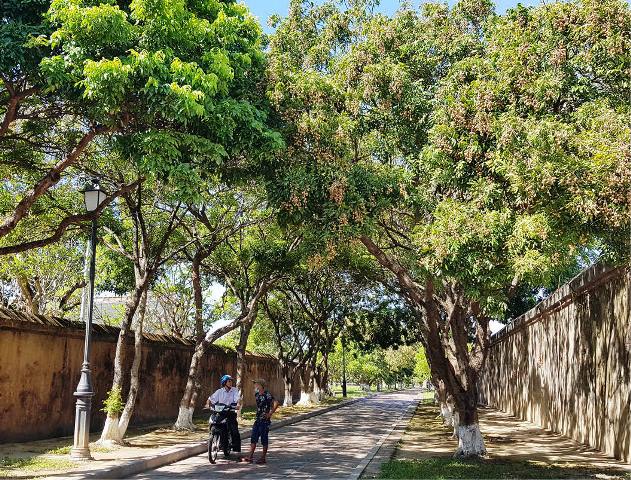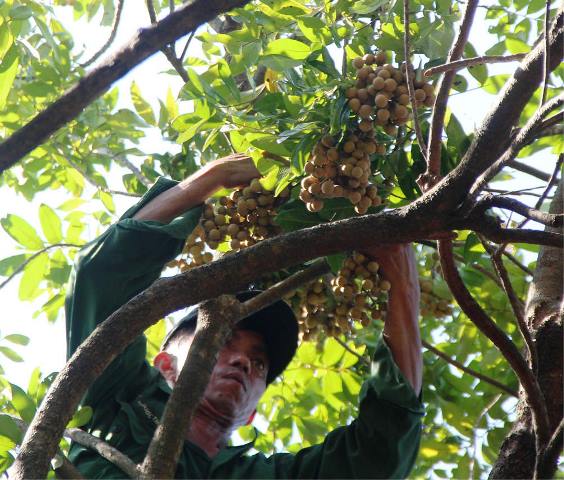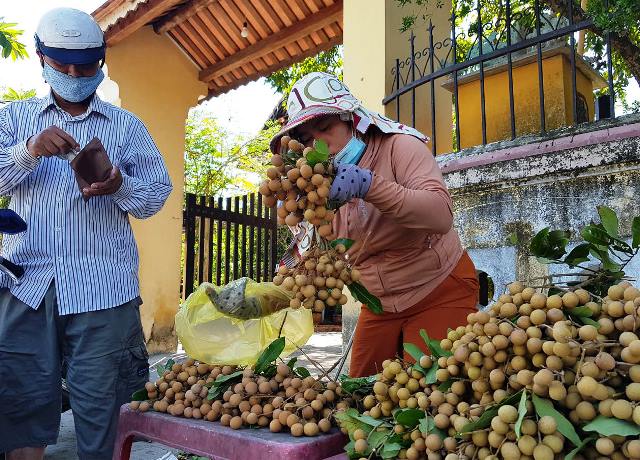Hue longan is inherently well-known, and the longan grown inside the royal palace also fascinates people with its distinctive delicious taste, as the folk expression goes: “ăn ngậm mà nghe” (“yummy").

The rows of longan trees inside Đại Nội are laden with fruit
In mid-July, we followed a group of people into the royal palace to pick longan. Inside Hoa Binh (Peace) Gate, the space was airy and cool; the temperature dropped a few degrees, different from the hot and sunny weather outside. From afar, bunches of golden ripe longan could be clearly seen from below the trunk to the towering branches.
Golden royal longan
Going along the paths to the palaces inside Đại Nội, longan trees planted in neat rows not only provide shade, but also have an attraction for being laden with fruits. Under the influence of the pandemic, there were few visitors. When we entered, only a few visitors and longan pickers were busy working "in the air", one tree after another.

Elaborate climbing and picking to avoid dropping and spoiling
"This year's longan has a bumper crop, but unluckily, the customers are few, so the sale will be probably slower than in previous years," Duong Van Loi, who "won the contract" for this year's longan inside Đại Nội, said leading us to the system of longan trees around the royal palace. Wherever he came, Mr. Loi reached out for longan and told me to try each.
With more than 20 years of experience in “biding for" longan everywhere, he said that Hue longan in general and Đại Nội longan are smaller this year under the influence of the prolonged heat. However, no matter how small it is, its taste does not change by any means. It is because Đại Nội longan always has a special sweet taste; the flesh fiber is neither too thick nor too thin, with moderate brittleness and wetness.
After walking around Đại Nội for a while, Loi took us to the route to the entrance to Hiển Lâm Các Gate, where many people were hired by him to pick longan. With a moderate area, this zone has many longan trees planted in rows, with branches intertwined.
In order to pick bunches of longan fully, without dropping, losing their beauty, pickers must be experienced. Also based on the height and age of the tree, pickers will use a ladder or climb up directly.
Vu, a man over 30, swinging on the longan tree trunks to take down delicious fruit in the royal palace from the high tree, joked that it is not easy at all to have bags of longan for sale.
“Not everyone can see this scene. Swinging like a monkey, all day.” With the experience of being hired to pick longan for nearly ten years, Vu said for the dense trees, it’s possible to erect ladders upright and rely on the canopy to climb up to pick; for some other trees, it’s necessary to climb directly.
“All the picked bunches of longan are promptly put into the bag. For the far-off bunches, a pole with a hook has to be used. Be gentle, or else they will fall to the ground. What a pity,” Vu continued, “If any bag is full, it will be gently dropped to the ground with a rope."
And every day, Loi's group of longan-pickers picks about 400-500kg; the price per kilogram is about 40,000 VND. Mr. Loi has all the bags of longan transported straightaway to the streets around Hoàng thành (Imperial Citadel) for his wife to sell. Longan is sold out in an instant. Some buyers wait; others place an order in advance by phone.
"Besides eating, people also buy longan to worship or send to friends from afar," said Mr. Loi. According to Mr. Loi, if not hard hit by the pandemic, right after being picked, longan will be bought on the spot by numerous visitors to Đại Nội. The quantity of picked longan cannot satisfy the buyers’ demand.
Distinctively delicious taste
Despite many years of "bidding for” longan in Đại Nội, as Loi said, he could not work out the quantity of longan at this place. Nowadays, the longan trees provide mainly shade, so fruit borne are unequal. But because of the enormous quantity, the picking time lasts… the whole month.

Đại Nội longan are on the market on Dang Thai Than Street, Hue City
According to some researchers and green tree experts, the ancient longan of Hue in general and of Đại Nội in particular is mainly the precious longan variety from Hung Yen. From within Đại Nội, longan was allowed by the king to plant outside the residences of royalties, princes, princesses and mandarins in the Imperial Capital and exists to this day.
Researcher Pham Duc Thanh Dung (officer of Hue Monuments Conservation Center) said that for 143 years, Hue was the Imperial Capital of the Nguyen Dynasty. Everything good, beautiful from people, culture even to varieties of fruit trees from all over the country gathered in the capital. For that reason, today, it can be seen that Hue, especially inside Đại Nội, has a wide variety of fruit from different regions, one generation after another.
Notably, longan is a special tree. Although developed on a harsh - climate land like Hue, it itself fought the disadvantages of nature to produce delicious and precious fruit, despite the fact that its yield is not as high as that in other regions.
“The harsh climate makes it very difficult to tend. However, once a longan tree has grown well, it will crystallize, flower and bear fruit, creating a unique and wonderful specialty, which is even more unique than the original tree previously taken to the Imperial Capital", Mr. Dung explained.
Dr. Le Cong Son, Chief of Office of Hue Monuments Conservation Center, said that the planting of fruit trees in the old palace was calculated very carefully. Hue Court architecture is landscape architecture, so the Nguyen dynasty kings had many rare plants collected from all parts of the country to grow in the royal palace.
Among them, the Nguyen kings were very fond of multi-use trees, especially fruit trees. This is because fruit trees not only provide shade but also supply wood and bear fruit to eat seasonally.
Among the many trees favored by the kings were litchi, jackfruit, mango and longan. Therefore, it can be clearly seen that longan trees were planted around the monuments and exist to this day.
“The most and the most delicious are the longan trees grown inside Đại Nội, especially the longan trees grown in Phung Tien Palace area. Therefore, the folk verse goes: “Vải trạng cung Diên / Nhãn lồng Phụng Tiên / Đào tiên Thế miếu” ("Diên Palace's lychee for the first doctoral candidate / Phụng Tiên’s bagged longan / King Temples’ fairy peach"). Mr. Son explained and said firmly that the longan taste here is sweet and delicious, totally different from that in other regions. Yet more wonderfully, Đại Nội longan, if combined with the white lotus of Tinh (Mediation) Lake, will create món chè (sweet soup) of "immortal reputation".
With that uniqueness, Mr. Son said, Hue Monuments Conservation Center planned to propagate to plant in some roads, shrine areas... in order to create landscape, shade and preserve these precious varieties of fruit trees. In addition, we proceed to propagate for the people to grow for developing a special product of the Ancient Capital in the eyes of many visitors everywhere.
Story and photos: Nhat Minh